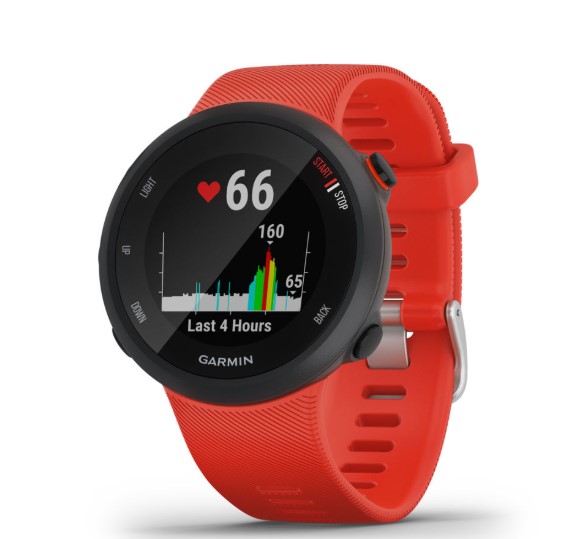
Garmin has been slowly updating its smartwatches and fitness trackers over the past few years, and 2019 appears to be the year of the Forerunner. Today, Garmin announced three new types of Forerunner smartwatches—the Forerunner 45 and 45S, the Forerunner 245 and 245 Music, and the Forerunner 945—that will replace all but one of its existing Forerunner lineup. The remaining device is the $449 Forerunner 645 Music, which came out about one year ago and was the first of Garmin’s wearables to have onboard music storage.
The new devices that make up the new lineup have slightly new designs and many new features. However, Garmin’s naming system doesn’t really help differentiate one smartwatch from another, so we’ll break down the devices here. The most affordable of the bunch are the Forerunner 45 and 45S, both of which start at $199. The “S” signifies a smaller case size, so users can choose between the 42mm Forerunner 45 or the 39mm Forerunner 45S.
Garmin says these are designed for newbie runners or those starting a new exercise plan, and that thinking likely led to its affordable price tag and its array of features. Like most Garmin smartwatches, the Forerunner 45 and 45S track all-day activity and sleep, deliver smartphone alerts to your wrist, and are easy on the eyes thanks to an always-on, sunlight-friendly display. Even though the Forerunner 45 watches are the most affordable of the bunch, they still have a heart-rate monitor and built-in GPS, so users can make outdoor runs without the help of a smartphone.
Other workout profiles are available on the watches as well, like elliptical and yoga, and it will calculate Garmin’s Body Battery score, which tells you how to plan workouts and rest periods based on your current lifestyle. Both the Forerunner 45 and 45S should last one week on a single charge when in smartwatch mode and up to 13 hours in GPS mode.
If you take everything the Forerunner 45 watches can do and add music storage, pulse ox, and running dynamics tracking, you get the Forerunner 245 and 245 Music (which start at $299 and $349, respectively). This device is designed for runners who have a bit more miles under their belts but aren’t training for triathlons yet. The 245 Music can hold up to 500 songs from various partner platforms including Spotify, Pandora, and Deezer, as well as a user’s personal tracks. The sensors inside the Forerunner 245 watches will measure VO2 max, aerobic and anaerobic training effects, and pulse ox, or how your body absorbs oxygen into the blood.
It can also connect to external sensors like a running dynamics pod and heart-rate chest straps to capture more running data while you train. The Forerunner 245 watches have the same one-week battery life as the Forerunner 45 watches do when in smartwatch mode, but they’ll last up to 24 hours in GPS mode or six hours when using GPS and music playback simultaneously.
The $599 Forerunner 945 can do everything the Forerunner 245 Music can do and more. It can hold up to 1,000 songs and will have even more onboard workout profiles to track, including skiing, hiking, golfing, and others. The 945 will also have NFC for Garmin Pay, so users can pay for coffee, groceries, and other things on their way home from a run without having their wallets.
Garmin added a new metric to this watch as well—dubbed training load focus, it will sort your recent activity into different training categories based on the structure and intensity of those activities. In addition to full-color, on-screen maps and trackable metrics that will please triathletes, the Forerunner 945 should last up to two weeks in smartwatch mode, 36 hours in GPS mode, or 10 hours when using GPS and music playback together.
The Forerunner family had six devices before and will continue to have six devices with this revamp, but the new smartwatches have modern designs that will appeal to fans of the Vivoactive series. They also fall more neatly into the categories listed on Garmin’s website: teammate, mentor, and expert. It’s possible that more runners will want to give the Forerunner series a try now, and more users will consider the series now that it’s better designed and that all of Garmin’s newest wearable features are represented across the board.
In addition to new devices, Garmin announced a big change coming to the Garmin Connect mobile app—female health tracking. Now, female users can input menstrual cycle and symptom information into a dedicated section of the Connect mobile app to track their cycles. I haven’t gotten a chance to test out the new features yet, but screenshots provided by Garmin show a menstrual-cycle tracker similar to Fitbit’s and that of dedicated female health-tracking apps. Garmin’s technology will also provide training and nutritional suggestions based on the information users provide, and those with a Garmin wearable can get cycle information and tracking reminder alerts on their wrists if they please.
Fitbit introduced female health tracking into its mobile app last year—while Fitbit’s app has always been more user-friendly than Garmin Connect, the addition of female health tracking made it that much more inclusive. Now that Garmin has a similar feature, female users have more options when it comes to smartwatches and fitness trackers that have companion apps in which they can track all different aspects of their health.
Menstrual-cycle tracking will be available in the Garmin Connect app soon via an update. The Forerunner 45 and 45S will be available in May, while the Forerunner 245, Forerunner 245 Music, and the Forerunner 945 are available today on Garmin’s website. Keep an eye out on Ars for Forerunner smartwatch reviews in the coming weeks.





























